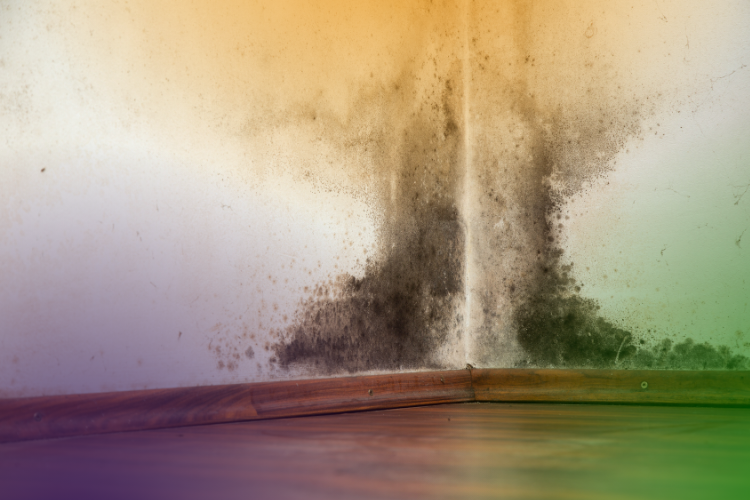Dealing With Black Mould
One of the most common household problems, and one of the hardest to resolve, is black mould. Most of us will have come across it at some point in our lives, and are aware that black mould isn’t that great for health. It’s often tricky to get rid of, but not impossible.
What Exactly Is Black Mould?
Black mould isn’t just one thing. It’s the name for a range of moulds and fungus which all have dark colours, ranging from green and brown through to black. As with all moulds, black mould needs a warm and damp atmosphere to grow in. Black mould produces mycotoxins, little spores which are invisible to the naked eye but which can make people who have asthma and other breathing difficulties very ill. In addition to breathing difficulties, high levels of black mould spores can cause allergic-type reactions such as a runny nose or eye irritation, cough and sneezing. The NHS suggests that anyone living in a home where there is black mould should take steps to get rid of it as soon as possible. This is especially the case when black mould is in bedrooms.
What Causes Black Mould?
Black mould is primarily a side effect of condensation. Moulds and fungus love damp conditions, so perhaps the room which is most affected is the bathroom, where the room fills with warm, damp steam every time someone takes a shower or a bath. However, black mould isn’t limited to the bathroom only. It can really appear anywhere in the house where there is either poor ventilation, or an underlying damp problem. The first sign of an undetected water leak might be black mould appearing on internal walls. Maintenance problems like dripping gutters or leaking tiles on the roof shouldn’t be ignored as black mould might be the least of your worries.
Daily activities might have an impact on the build-up of black mould in the house too. We’ve already mentioned poor ventilation when showering, but boiling pans on the stove or drying washing inside the house can have a similar effect. Even just having a lot of people breathing out warm air in a confined space can lead to the growth of black mould. If you’re not sure whether your home could be classed as humid or not, buy a cheap moisture meter from the local DIY store. Ideally, the humidity inside the house should be between 30% and 60%,
Dealing With Black Mould Easily
Often, dealing with black mould is as simple as opening the window. Allow the water vapour to escape when you are cooking pasta for dinner, having a shower or drying washing inside. If you have a serious issue with black mould, then it might be worth keeping windows open slightly throughout the day, or whenever you’re at home. The problem is, that during a cold British winter, many of us are reluctant to do this as opening windows lets the cold in as well as the water vapour out.
Another major issue is heating. If a home isn’t adequately heated, then the dampness doesn’t get the chance to dry out in the walls, and the mould thrives. Insulation can also have a major impact on how warm your home is, and therefore how readily the black mould will form. However, although ramping up your insulation will address some of the underlying problems associated with black mould, it’s often a major job, and disruptive.
Cleaning Off Black Mould
There are all manner of sprays and cleaning liquids which you can use to treat the black mould when it appears on your walls, and most of them are highly effective. Nearly all mould and mildew removing products are bleach based. Spray them onto the affected area, leave for a short while to kill off the mould, and then wipe clean. Mould and mildew removers are ideal for removing small amounts of black mould, such as mould which appears on the grout in the shower, or on a shower curtain. If you’d prefer to try natural remedies, then white vinegar and tea tree oil might be just as effective against the mould. However effective the mould removers are you should remember that they are only treating the symptoms of the black mould problem not the underlying dampness cause. If you find that you’re getting through increasingly larger quantities of sprays and that the mould just keeps returning, then it’s time to consider what other steps you might want to take.
Improving Ventilation To Fight Black Mould
Improving ventilation and air circulation is absolutely the best thing you can do to reduce the risk of black mould. Windows should be left open when showering, drying washing, cooking or ironing. If you’re concerned about security, you can get special sliding latches which allow the windows to be pushed open by a couple of inches, but no more. Many modern double-glazed windows are fitted with trickle vents at the top of the window, and these should be left open to increase ventilation too. Try to get into the habit of leaving doors open to allow the damp air to disperse over a wider area, rather than remain concentrated in the one area. That doesn’t mean leaving the doors open while you’re in the shower if you don’t want to. Once you’ve finished your shower, leave the door open while you dress to allow any dampness to clear.
If you’ve tried opening the windows and leaving doors ajar and there doesn’t seem to be any impact on the growth of black mould, then you may have to consider other ways of ventilating the room. Extractor fans are widely available and can be fitted into either an outside wall, or vented through the ceiling of your property. Get some expert advice from an electrician on the type of fan which is most appropriate for your needs. You should expect to pay around £200 for a professional to fit a new extractor fan for you. You can choose whether to operate the fan manually with a pull cord, or to wire it up to the light switch so that it comes on automatically.
Can I Treat Black Mould With a Dehumidifier?
Dehumidifiers work by pulling damp air out of your room, condensing it to remove the water and filling a tank which you then empty down the sink. Dehumidifiers won’t do anything to kill off the mould, but might help you address the issues with dampness in the home while you are deciding what other measures you might want to take. A basic dehumidifier will cost around £50, but will only remove around 250ml of water per day. For around £200, you can buy a much larger dehumidifier which will remove as much as 18 litres of water. The downside is that larger units can be noisy to run. If however you’ve established that your issue is due to drying washing in the house or some other factor, then the dehumidifier may be the best option.
Can Leaks and Guttering Cause Black Mould?
If there’s nothing obvious going on inside the house with excess condensation and lack of ventilation, then the mould might be caused by dampness penetrating into your home from the outside. Now, there can be any number of explanations for this and reasons why it might happen. Often however the main culprit is your guttering. Over time gutters can get blocked with leaves, moss and all sorts of other debris. If it rains heavily, the gutters will overflow and the water runs down the walls. Over time, this can cause walls to become very damp and lead to black mould on internal surfaces. Get your gutters cleared out regularly and the next time it rains heavily, go outside to see whether you can spot any places where the water isn’t draining properly. If you spot water pooling in your garden or on paving, then the issue might be with a burst pipe somewhere on your property. This can be expensive to treat, so seek advice from a plumber or your water provider before agreeing to any expensive investigatory treatment.
Using Insulation and Warmth to Beat Black Mould
A warm house is just as important as a dry one when it comes to beating black mould. Most British homes aren’t properly insulated, and increasing the amounts of insulation in your loft or in the cavity walls can have the dual benefit of curing the black mould, and reducing your heating bills. Although the government schemes for insulating homes aren’t as generous as they used to be, there is still money around to help pay towards energy efficiency work for people on low incomes. Check with your energy provider to see whether you qualify. If you don’t check out your local DIY store to see what promotions are running on the various types of insulation, many of which are easy to install yourself. Renters who are in damp properties which are difficult to heat can get support from charities such as Shelter to help improve their homes.



